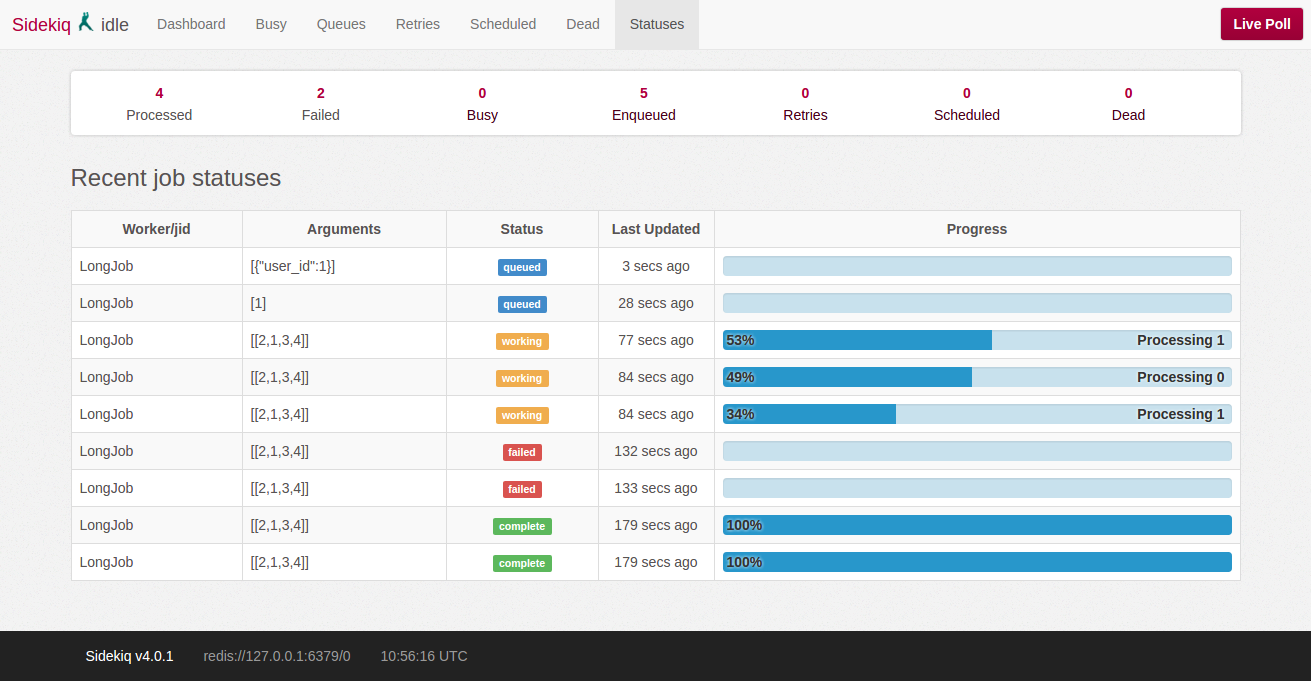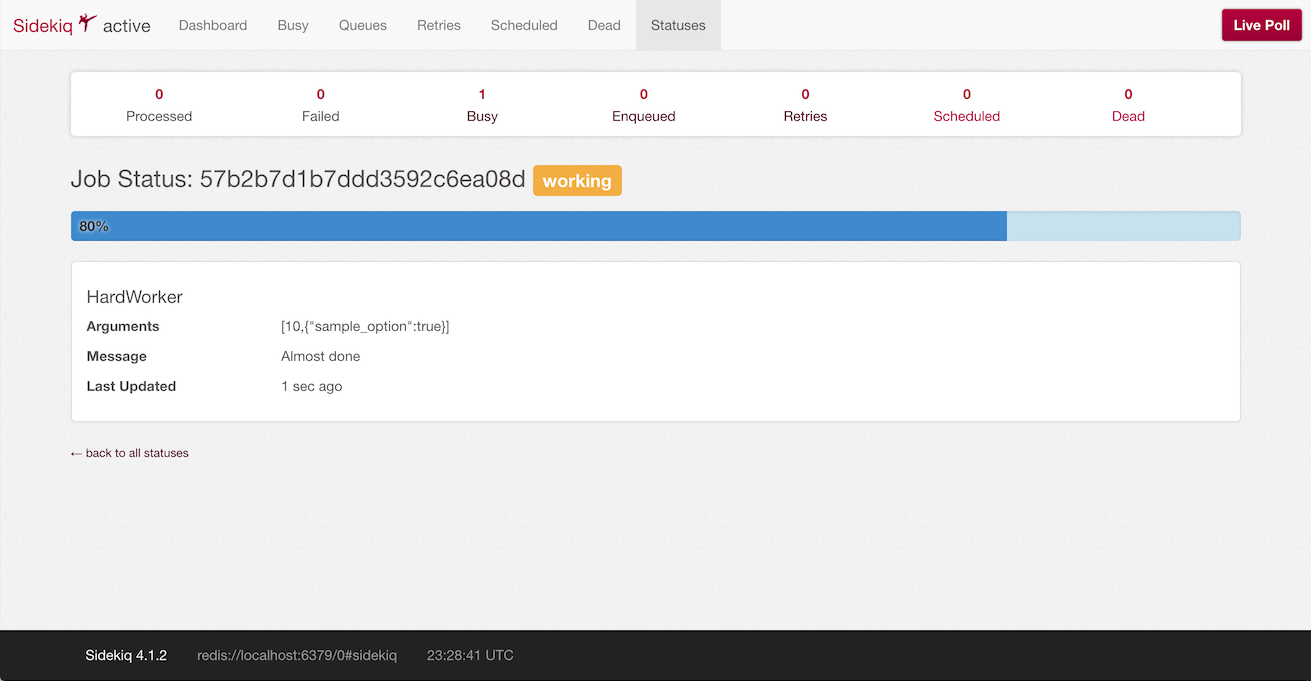Sidekiq-status is an extension to Sidekiq that tracks information about your Sidekiq and provides a UI to that purpose. It was inspired by resque-status.
Requires Ruby 2.6+ and Sidekiq 5.0+ or newer.
Add this line to your application's Gemfile:
gem 'sidekiq-status'Or install it yourself as:
gem install sidekiq-statusVersion 2.0.0 was published in order to add support for Ruby 3.0 and Sidekiq 6.x and to remove support for versions of both that are now end-of-life. You should be able to upgrade cleanly from version 1.x to 2.x provided you are running Sidekiq 5.x or newer.
Sidekiq-status version 1.1.4 provides support all the way back to Sidekiq 3.x and was maintained at https://github.com/utgarda/sidekiq-status/.
To get started:
- Configure the middleware
- (Optionally) add the web interface
- (Optionally) enable support for ActiveJob
To use, add sidekiq-status to the middleware chains. See Middleware usage on the Sidekiq wiki for more info.
require 'sidekiq'
require 'sidekiq-status'
Sidekiq.configure_client do |config|
# accepts :expiration (optional)
Sidekiq::Status.configure_client_middleware config, expiration: 30.minutes
end
Sidekiq.configure_server do |config|
# accepts :expiration (optional)
Sidekiq::Status.configure_server_middleware config, expiration: 30.minutes
# accepts :expiration (optional)
Sidekiq::Status.configure_client_middleware config, expiration: 30.minutes
endInclude the Sidekiq::Status::Worker module in your jobs if you want the additional functionality of tracking progress and storing / retrieving job data.
class MyJob
include Sidekiq::Worker
include Sidekiq::Status::Worker # enables job status tracking
def perform(*args)
# your code goes here
end
endNote: only jobs that include Sidekiq::Status::Worker will have their statuses tracked.
To overwrite expiration on a per-worker basis, write an expiration method like the one below:
class MyJob
include Sidekiq::Worker
include Sidekiq::Status::Worker # enables job status tracking
def expiration
@expiration ||= 60 * 60 * 24 * 30 # 30 days
end
def perform(*args)
# your code goes here
end
endThe job status and any additional stored details will remain in Redis until the expiration time is reached. It is recommended that you find an expiration time that works best for your workload.
As sidekiq-status stores information about jobs in Redis, it is necessary to set an expiration time for the data that gets stored. A default expiration time may be configured at the time the middleware is loaded via the :expiration parameter.
As explained above, the default expiration may also be overridden on a per-job basis by defining it within the job itself via a method called #expiration.
The expiration time set will be used as the Redis expire time, which is also known as the TTL (time to live). Once the expiration time has passed, all information about the job's status and any custom data stored via sidekiq-status will disappear.
It is advised that you set the expiration time greater than the amount of time required to complete the job.
The default expiration time is 30 minutes.
You may query for job status any time up to expiration:
job_id = MyJob.perform_async(*args)
# :queued, :working, :complete, :failed or :interrupted, nil after expiry (30 minutes)
status = Sidekiq::Status::status(job_id)
Sidekiq::Status::queued? job_id
Sidekiq::Status::working? job_id
Sidekiq::Status::retrying? job_id
Sidekiq::Status::complete? job_id
Sidekiq::Status::failed? job_id
Sidekiq::Status::interrupted? job_idImportant: If you try any of the above status method after the expiration time, the result will be nil or false.
This gem also supports ActiveJob jobs. Their status will be tracked automatically.
To also enable job progress tracking and data storage features, simply add the Sidekiq::Status::Worker module to your base class, like below:
# app/jobs/application_job.rb
class ApplicationJob < ActiveJob::Base
include Sidekiq::Status::Worker
end
# app/jobs/my_job.rb
class MyJob < ApplicationJob
def perform(*args)
# your code goes here
end
endsidekiq-status comes with a feature that allows you to track the progress of a job, as well as store and retrieve any custom data related to a job.
class MyJob
include Sidekiq::Worker
include Sidekiq::Status::Worker # Important!
def perform(*args)
# your code goes here
# the common idiom to track progress of your task
total 100 # by default
at 5, "Almost done" # 5/100 = 5 % completion
# a way to associate data with your job
store vino: 'veritas'
# a way of retrieving stored data
# remember that retrieved data is always String|nil
vino = retrieve :vino
end
end
job_id = MyJob.perform_async(*args)
data = Sidekiq::Status::get_all job_id
data # => {status: 'complete', update_time: 1360006573, vino: 'veritas'}
Sidekiq::Status::get job_id, :vino #=> 'veritas'
Sidekiq::Status::at job_id #=> 5
Sidekiq::Status::total job_id #=> 100
Sidekiq::Status::message job_id #=> "Almost done"
Sidekiq::Status::pct_complete job_id #=> 5scheduled_job_id = MyJob.perform_in 3600
Sidekiq::Status.cancel scheduled_job_id #=> true
# doesn't cancel running jobs, this is more like unscheduling, therefore an alias:
Sidekiq::Status.unschedule scheduled_job_id #=> true
# returns false if invalid or wrong scheduled_job_id is provided
Sidekiq::Status.unschedule some_other_unschedule_job_id #=> false
Sidekiq::Status.unschedule nil #=> false
Sidekiq::Status.unschedule '' #=> false
# Note: cancel and unschedule are alias methods.Important: If you schedule a job and then try any of the status methods after the expiration time, the result will be either nil or false. The job itself will still be in Sidekiq's scheduled queue and will execute normally. Once the job is started at its scheduled time, sidekiq-status' job metadata will once again be added back to Redis and you will be able to get status info for the job until the expiration time.
Job status and metadata will automatically be removed from Redis once the expiration time is reached. But if you would like to remove job information from Redis prior to the TTL expiration, Sidekiq::Status#delete will do just that. Note that this will also remove any metadata that was stored with the job.
# returns number of keys/jobs that were removed
Sidekiq::Status.delete(job_id) #=> 1
Sidekiq::Status.delete(bad_job_id) #=> 0This gem provides an extension to Sidekiq's web interface with an index at /statuses.
Information for an individual job may be found at /statuses/:job_id.
Note: only jobs that include Sidekiq::Status::Worker will be reported in the web interface.
To use, setup the Sidekiq Web interface according to Sidekiq documentation and add the Sidekiq::Status::Web require:
require 'sidekiq/web'
require 'sidekiq-status/web'Drawing analogy from sidekiq testing by inlining,
sidekiq-status allows to bypass redis and return a stubbed :complete status.
Since inlining your sidekiq worker will run it in-process, any exception it throws will make your test fail.
It will also run synchronously, so by the time you get to query the job status, the job will have been completed
successfully.
In other words, you'll get the :complete status only if the job didn't fail.
Inlining example:
You can run Sidekiq workers inline in your tests by requiring the sidekiq/testing/inline file in your {test,spec}_helper.rb:
require 'sidekiq/testing/inline'
To use sidekiq-status inlining, require it too in your {test,spec}_helper.rb:
require 'sidekiq-status/testing/inline'
Bug reports and pull requests are welcome. This project is intended to be a safe, welcoming space for collaboration, and contributors are expected to adhere to the Contributor Covenant code of conduct.
- Fork it
- Create your feature branch (
git checkout -b my-new-feature) - Commit your changes along with test cases (
git commit -am 'Add some feature') - If possible squash your commits to one commit if they all belong to same feature.
- Push to the branch (
git push origin my-new-feature) - Create new Pull Request.
- Pramod Shinde
- Kenaniah Cerny
- Clay Allsopp
- Andrew Korzhuev
- Jon Moses
- Wayne Hoover
- Dylan Robinson
- Dmitry Novotochinov
- Mohammed Elalj
- Ben Sharpe
MIT License, see LICENSE for more details. © 2012 - 2016 Evgeniy Tsvigun

